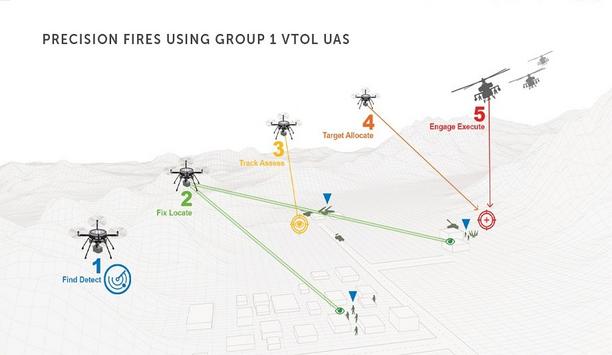Teledyne e2v Limited - Experts & Thought Leaders
Latest Teledyne e2v Limited news & announcements
Teledyne FLIR Defence has announced that Dr. Kemper Talley was named the 2022 Joseph D. Wienand Science, Technology, Engineering, and Math (STEM) Excellence Award winner. The award was presented by the National Defense Industrial Association (NDIA) at its 2022 Chemical Biological Radiological and Nuclear (CBRN) Conference and Exhibition in Baltimore. Real-time AR visualisation Teledyne FLIR Vice President and General Manager of Detection - Dr. David Cullin, and Director of Science & Technology - Dr. Jeremy Walker, served as conference panelists, while Director of Business Development - Jay Reckard moderated two panels at the event. Dr. Talley is currently pioneering the development of real-time, 3D CBRN threat mapping and augmented reality (AR) visualisation of threats through programmes in which Teledyne FLIR serves as prime contractor for the U.S. Department of Defense. Situational awareness and safety (His) innovation, creativity, and passion in the areas of STEM have directly impacted the improvement of CBRN defence" In its award citation, NDIA officials wrote, “Dr. Talley is at the forefront of creating digital CBRN battlefield capabilities that will improve warfighter situational awareness and safety by enabling them to more efficiently conduct CBRN recon and decon missions. (His) innovation, creativity, and passion in the areas of STEM have directly impacted the improvement of CBRN defence.” Threat detection technology “Kemper is a highly skilled scientist whose contributions are pushing the envelope not only for threat detection technology but also in how threat data is seen, shared, and managed on today’s battlefield,” said Teledyne FLIR’s Cullin. “He and the rest of our team in labs across the United States are working closely with Pentagon programme offices to optimise our ability to defend against weapons of mass destruction. Our goal is to allow warfighters to see previously unseen threats and avoid them,” Cullin added. Dr. Talley's education Dr. Talley is a principal investigator and theoretical physicist at Teledyne FLIR’s facility in Oak Ridge, Tenn. He graduated summa cum laude with a B.S. in Physics from Clemson University before obtaining his Ph.D. in Energy Science and Engineering with a concentration in Nuclear Science at the Bredesen Center for Interdisciplinary Research and Graduate Education at the University of Tennessee, Knoxville.
Teledyne FLIR Defense, part of Teledyne Technologies Incorporated has collaborated with AM General to display its Lightweight Vehicle Surveillance System (LVSS) on a HUMVEE 2-CT (2-Door Cargo Truck) during the Association of the U.S. Army (AUSA) annual conference 2022. The display is a technology demonstrator for future Army mobile command and control (C2) vehicles, integrating newly advanced radar, long-range cameras, and other sensors to detect and defeat threats such as weaponised small Unmanned Aerial Systems (sUAS). Lightweight Vehicle Surveillance System (LVSS) With its cutting-edge air domain awareness technology, LVSS fits in the back of the HUMVEE 2-CT, ready to provide counter-UAS; Intelligence, Surveillance, and Reconnaissance (ISR); and force protection capabilities. LVSS features a 16-ft. fully retractable mast that leverages a combination of 3D radar, EO/IR camera, plus RF detection The LVSS platform features a 16-ft. fully retractable mast that leverages a combination of 3D radar, electro-optical/infrared (EO/IR) camera, plus RF detection and mitigation sensors to provide early warning alerts and recognition. Ready to meet the requirements of several Army programs, including Command Post Integrated Infrastructure (CPI2) and Ground-Based Operational Surveillance System-Expeditionary (GBOSS-E), the capability concept would aid commanders with multi-domain decision support in a mobile C2 vehicle. StormCaster™-DX Also on display for the first time at AUSA is StormCaster™-DX, a multi-role laser designator payload built especially for use on FLIR’s R80D SkyRaider™ Group 1 sUAS. StormCaster-DX is uniquely designed to manage target areas using a Laser Spot Tracker while affecting the terminal guidance of laser-guided munitions. Until recently, this capability was only possible with larger UAS platforms or ground-based systems. Teledyne FLIR’s whitepaper published two weeks ago, ‘The Proliferation of Precision Fires,’ explores how troops can benefit from technology that enables them to call and direct fires on the battlefield anytime, in any environment. StormCaster-E Teledyne FLIR Defense also is introducing StormCaster-E, the latest in its StormCaster payload series designed for the company’s sUAS aircraft. The new long-range imaging sensor features a fully integrated EO camera built for demanding missions that require clear and precise imagery across daylight and low-light conditions. Mobility and agility LVSS provides mobile surveillance that can be quickly redeployed as threats change" “This first-time concept showcasing our LVSS in a HUMVEE truck illustrates how we can reduce the current command post footprint, while at the same time improving mobility and agility,” said Dr. JihFen Lei, executive vice president, and general manager of Teledyne FLIR Defense. Dr. JihFen Lei adds, “LVSS brings a host of sophisticated sensing technologies onto one platform. It provides mobile surveillance that can be quickly redeployed as threats change, a critical need on today’s battlefield as evidenced by events in Eastern Europe.” Performance “We’re also proud to launch our rugged new StormCaster-E payload, which marks a major leap forward in performance, line of sight stabilisation, and range of motion for a low SWaP-C package,” Dr. JihFen Lei added. AUSA attendees can see all these technology solutions and more at Teledyne FLIR, Booth 6915 in Hall E.
In a new whitepaper, Teledyne FLIR Defense, part of Teledyne Technologies Incorporated explores the critical importance of precision fires to address capability gaps on the battlefield and engage a new generation of enemy threats. The whitepaper also examines game-changing Laser Target Designator (LTD) technology employed by Group 1 small Unmanned Aircraft Systems (sUAS) that can resolve operating constraints, speed decision-making, and boost the mission success of precision strikes. The Proliferation of Precision Fires The paper, ‘The Proliferation of Precision Fires,’ discusses how every warfighter on the battlefield benefits from technology that enables them to call for fires anytime and in any environment. Precision fires rely upon the accurate delivery of precision-guided munitions onto targets using a variety of methods. Options include laser or Global Positioning System (GPS) guidance systems, as well as inertial navigation units embedded into the munition, any of which help deliver an effect to within several metres of a target, even at extended ranges. Strategic importance Warfighters face a new generation of threats on today’s battlefield that require new capabilities" The strategic importance of precision fires continues to be underlined by the ongoing war in Ukraine. Ukrainian Armed Forces have successfully deployed precision fires to destroy Russian positions and materiel while minimising collateral damage to civilian populations and critical infrastructure. “Warfighters face a new generation of threats on today’s battlefield that require new capabilities to ensure ‘overmatch’ against near-peer adversaries,” said Dr. JihFen Lei, Executive Vice President, and General Manager of Teledyne FLIR Defense. Recent advancements Dr. JihFen Lei continues, “The ability to call and direct fires anytime anywhere is crucial, and our whitepaper explores advanced laser target designator technologies that can enhance the effectiveness of precision fires." “Recent advancements will enable units operating at the lowest tactical level to quickly set up a small UAS; attach an LTD; and then launch, find, and designate targets for laser-guided munitions from safer, stand-off positions,” Lei added. Key findings Key findings include: Heavily relied upon during counter-insurgency campaigns of the last two decades, precision fires are re-emerging as a significant enabler for modern armed forces operating against near-peer adversaries in the age of strategic competition. The proliferation of precision fires is clear to see within the U.S. Dept. of Defense alone, which appropriated 39,500 munitions in FY2021 with a further 16,700 requested in FY2022. Long Range Precision Fires are the U.S. Army’s top modernisation priority while, similarly, Organic Precision Fires (OPF) are part of the U.S. Marine Corps Force Design 2030 strategy. Warfighters on the ground operating LTDs face tactical challenges that include inaccessibility; size, weight, and power (SWaP) limitations; austere environments; and time limitations. Reduced SWaP LTDs can be integrated onboard Group 1 Vertical Takeoff/Landing (VTOL) sUAS, providing precision fires to the lowest tactical level and reducing targeting cycles from minutes to just seconds. Upgraded LTDs not only maximise the mission effectiveness of units at the tactical edge, but also extend use cases to include border security, vehicle interdiction, and maritime/coastal applications. A close companion of the LTD is the Laser Spot Tracker (LST). LST allows operators to see other platforms’ laser spots, enabling them to verify and correct spots from multiple sources. LST helps units orchestrate their mission by coordinating the various laser designating platforms, improving attack efficiency and effectiveness. Using sensors The paper concludes with a quote from U.S. Army Chief of Staff, General James McConville, who sums up the goals of the Pentagon’s approach to precision fires. General James McConville said, “We don’t want to be indiscriminate when we conduct precision strikes and as we move to the future, we’re going to be using all types of sensors. We are going to have a lot of capability for long-range fires and having people on the battlefield who can do that is going to be very important.”
The key to unlocking K12 school safety grants
DownloadHoneywell GARD USB threat report 2024
DownloadThe truth behind 9 mobile access myths
Download5 surprising findings from OT vulnerability assessments
DownloadPhysical access control
Download















